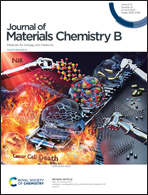Iridium(iii) complexes decorated with silicane-modified rhodamine: near-infrared light-initiated photosensitizers for efficient deep-tissue penetration photodynamic therapy†
Abstract
Meeting the demand for efficient photosensitizers in photodynamic therapy (PDT), a series of iridium(III) complexes decorated with silicane-modified rhodamine (Si-rhodamine) was meticulously designed and synthesized. These complexes demonstrate exceptional PDT potential owing to their strong absorption in the near-infrared (NIR) spectrum, particularly responsive to 808 nm laser stimulation. This feature is pivotal, enabling deep-penetration laser excitation and overcoming depth-related challenges in clinical PDT applications. The molecular structures of these complexes allow for reliable tuning of singlet oxygen generation with NIR excitation, through modification of the cyclometalating ligand. Notably, one of the complexes (4) exhibits a remarkable ROS quantum yield of 0.69. In vivo results underscore the efficacy of 4, showcasing significant tumor regression at depths of up to 8.4 mm. This study introduces a promising paradigm for designing photosensitizers capable of harnessing NIR light effectively for deep PDT applications.



 Please wait while we load your content...
Please wait while we load your content...